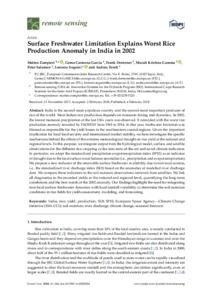Surface Freshwater Limitation Explains Worst Rice Production Anomaly in India in 2002
Abstract
India is the second-most populous country and the second-most important producer of rice of the world. Most Indian rice production depends on monsoon timing and dynamics. In 2002, the lowest monsoon precipitation of the last 130+ years was observed. It coincided with the worst rice production anomaly recorded by FAOSTAT from 1961 to 2014. In that year, freshwater limitation was blamed as responsible for the yield losses in the southeastern coastal regions. Given the important implication for local food security and international market stability, we here investigate the specific mechanisms behind the effects of this extreme meteorological drought on rice yield at the national and regional levels. To this purpose, we integrate output from the hydrological model, surface, and satellite observations for the different rice cropping cycles into state-of-the-art and novel climate indicators. In particular, we adopt the standardized precipitation evapotranspiration index (SPEI) as an indicator of drought due to the local surface water balance anomalies (i.e., precipitation and evapotranspiration). We propose a new indicator of the renewable surface freshwater availability due to non-local sources, i.e., the standardized river discharge index (SDI) based on the anomalies of modelled river discharge data. We compare these indicators to the soil moisture observations retrieved from satellites. We link all diagnostics to the recorded yields at the national and regional level, quantifying the long-term correlations and the best match of the 2002 anomaly. Our findings highlight the need for integrating non-local surface freshwater dynamics with local rainfall variability to determine the soil moisture conditions in rice fields for yields assessment, modeling, and forecasting

